How Does IoT's Future Look in 2024 & Beyond?
By 2027, it’s projected that the IoT market size will grow more than $2 trillion annually. This means in 2023, the expected level of expenditure in IoT is $1.1B.
But even though IoT market as a whole is expected to grow 9(Figure 2), IoT vendors may be uncertain about the prospects of individual industries or regions.
Figure “: IoT’s market size is forecasted to be worth $1.5T by 2025. Source: Statista
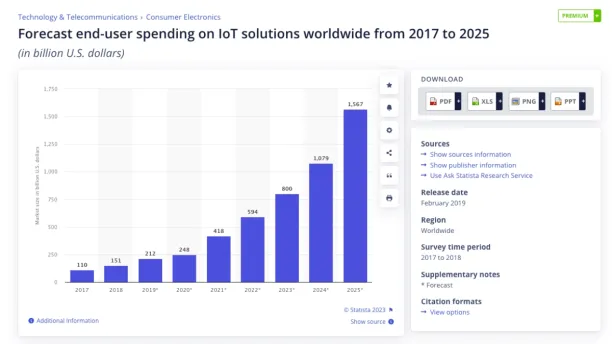
In this article, we will take a closer look at the specifics of the future of the IoT market, and present some industries that are ripe for being revolutionized by the IoT.
What industries will invest the most in IoT?
Per Statista, by 2020 (Figure 3):
- Discrete manufacturing (i.e. the location where the final inputs that make up a product are assembled)
- Transportation and logistics (e.g. shipment, fleet management)
- Utilities (water and resource management)
Each spent close to $40B.
The next sectors estimated to invest the most in IoT technology by 2020 were B2C enterprises, healthcare, retail, government, and insurance. You can see more industry-specific stats on IoT in our IoT statistics article.
Figure 3: Share of IoT Expenditure By Industry. Source: Statista
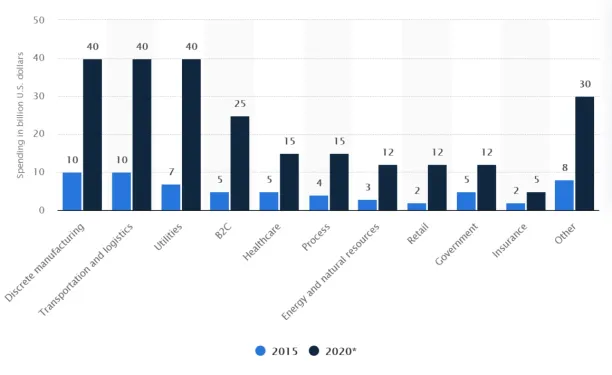
Recommendations: Offering IoT-related services to untapped markets such as retail, government, and healthcare will give you a head-start compared to your competitors.
What industries will spend the least on IoT?
The pandemic is not yet over. So the personal and consumer industry — including, but not limited to, hotels, theme parks, casinos, and movie theaters — could be the only sector experiencing a negative decline in IoT investment for the time being.
Whether or not all film industry producers will pivot in a manner that would bring the theater experience to movie-goers’, by increasing investment into smart home IoT entertainment tools, is still to be seen.
Recommendations: Limit your outreach into the entertainment industry for the time being.
What regions will invest the most in IoT?
Fortune Business Insight conducted a study that calculated and projected IoT expenditure across different regions between 2021 and 2028:
Figure 3: Increased Interest in the Word “IoT,” Especially in Scandinavian Countries, Like Finland. Source: Google Trend
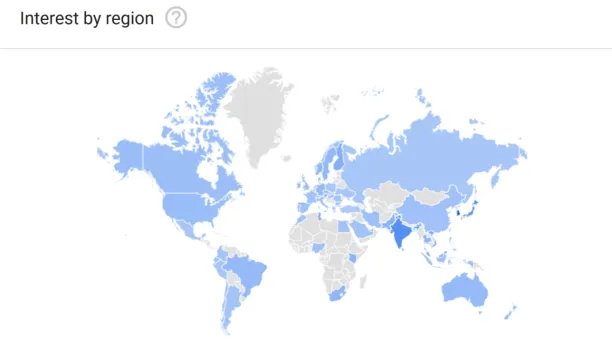
1- Asia Pacific
By their estimation, Asia Pacific will account for the maximum share of investment in IoT, owing to increasing smart city initiatives by the government and cloud spending in the region. East Asia’s network service providers are expanding their portfolios to monetize IoT possibilities through creating data collection systems. In the Far East, China currently accounts for 64% of the 1.5 billion global IoT connections and will continue to grow during the forecast period.
2- Europe
The European market is predicted to show the highest compound annual growth rate during the forecast period. Germany, the UK, France, Italy, Spain, and the Netherlands are at the forefront of European IoT adoptions. But Eastern Europe and Nordic countries (Figure 4) are trailing closely and could break the status quo.
3- North America
North America has made considerable progress in the adoption of IoT, especially in the manufacturing, industrial and automotive sectors. However, the rise in the number of data breaches has meant that during the predicted cohort, they will be focusing more on producing cybersecurity solutions than anything else. Per smartamerica.org, the US government will spend nearly $41 trillion in 20 years in updating its IoT security infrastructure.
4- Latin America, the Middle East, & Africa
Latin America, the Middle East, and Africa are the regions that are newcomers to the party but are on the brink of major breakthroughs. Countries such as Israel, Saudi Arabia, and the United Arab Emirates are amongst the fastest-growing nations in the region with respect to IoT. The market size of IoT in Saudi Arabia is expected to grow at an annual rate of 10% until 2025, surpassing the $27 billion thresholds, per a state official. And if it’s worth anything, they were the first country to grant citizenship to a robot, so we will continue to hear more about them in the future when it comes to investing in technology.
How will IoT help in future industry developments?
The following are everyday devices/services/jobs that would get the most overhaul thanks to IoT advancement:
- Cars: With the supply increase of the 5G networks around the globe, carmakers will be able to take advantage of IoT’s potential to increase the production, efficiency, and safety of driverless cars.
- Smart cities: More cities will be able to automate, remotely manage, and collect data through devices like visitor kiosks, video camera surveillance systems, bike rental stations, and taxis. In addition, they will invest in more IoT ecosystems that track data and allow for appropriate measures to be taken for resource management, traffic control, city planning, crime curtailing, and more.
- Smart buildings: Smart buildings in the EU (Figure 5) are on the rise. By leveraging data from a multitude of devices and sensors, smart buildings are creating a productive environment for the occupants by lighting, thermal comfort, air quality, physical security, sanitation and more at lower costs and environmental impact than buildings that are not connected.
Figure 5: Number of Smart Buildings Connections in the EU. Source: Statista
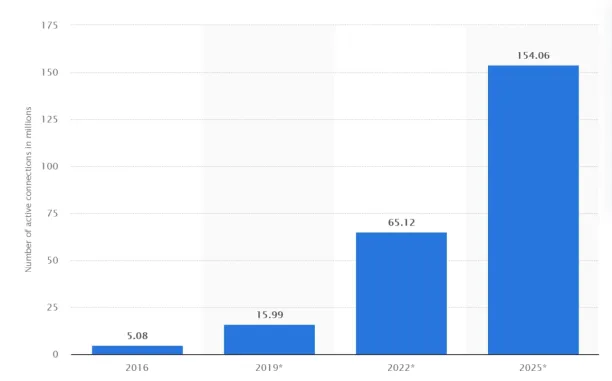
- Machine learning: Smart home hubs, thermostats, lighting systems, and even coffee makers collect data on your habits and patterns of usage. In most cases, the data is collected to help facilitate training of IoT devices that leverage machine learning to improve algorithm accuracy and predictions. Having access to larger amounts of data means machines can draw upon more resources to make themselves more integral to our everyday lives.
- Banking and finance: Banks will expand their use of sensors and data analytics to collect more data to provide us with personalized services.
- IoT in banking has the potential to help consumers cultivate healthy financial habits and curtail indulgences and improve the quality of the banking experience.
- Agriculture: Since the 1990s, there has been a decrease in the worldwide employment in agriculture relative to the global workforce. One reason why that’s happened is the increase in automation and IoT related technologies being used in agriculture. That has led to more food and greens of higher quality than ever before being brought to our dinner tables with less human intervention. That trend is only likely to continue more forcefully in the future.
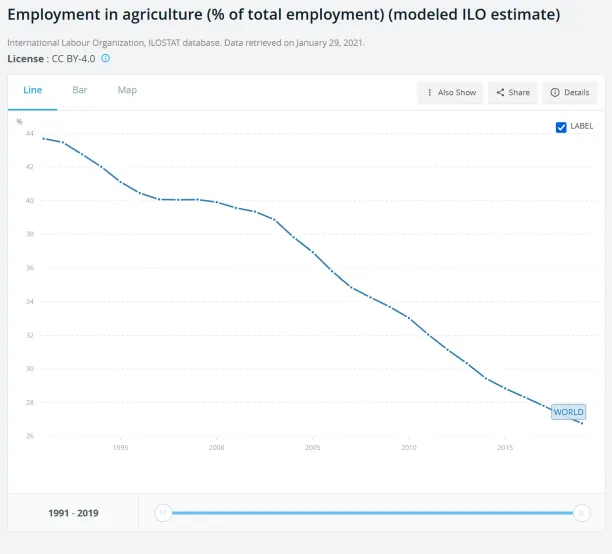
To showcase your product
If you are interested in growing, by including your IoT application in our data-driven list of vendors, visit Grow With AI Multiple.

Cem has been the principal analyst at AIMultiple since 2017. AIMultiple informs hundreds of thousands of businesses (as per similarWeb) including 60% of Fortune 500 every month.
Cem's work has been cited by leading global publications including Business Insider, Forbes, Washington Post, global firms like Deloitte, HPE, NGOs like World Economic Forum and supranational organizations like European Commission. You can see more reputable companies and media that referenced AIMultiple.
Throughout his career, Cem served as a tech consultant, tech buyer and tech entrepreneur. He advised businesses on their enterprise software, automation, cloud, AI / ML and other technology related decisions at McKinsey & Company and Altman Solon for more than a decade. He also published a McKinsey report on digitalization.
He led technology strategy and procurement of a telco while reporting to the CEO. He has also led commercial growth of deep tech company Hypatos that reached a 7 digit annual recurring revenue and a 9 digit valuation from 0 within 2 years. Cem's work in Hypatos was covered by leading technology publications like TechCrunch and Business Insider.
Cem regularly speaks at international technology conferences. He graduated from Bogazici University as a computer engineer and holds an MBA from Columbia Business School.
To stay up-to-date on B2B tech & accelerate your enterprise:
Follow on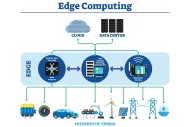
Comments
Your email address will not be published. All fields are required.